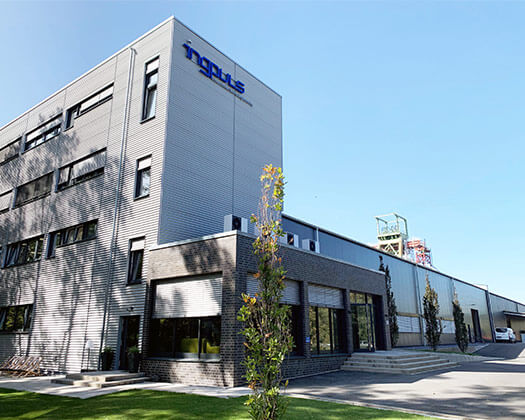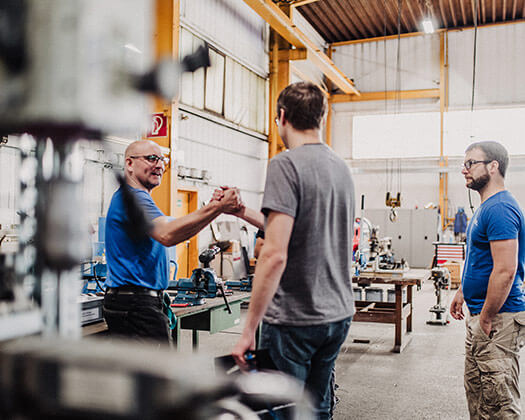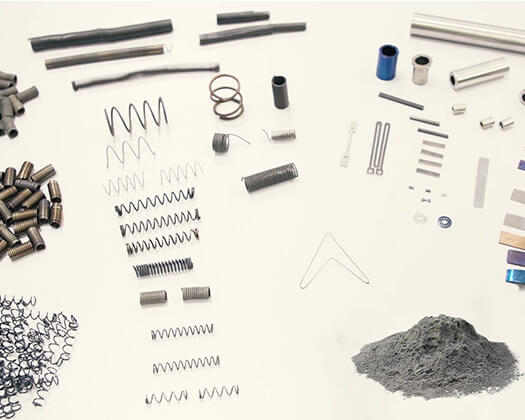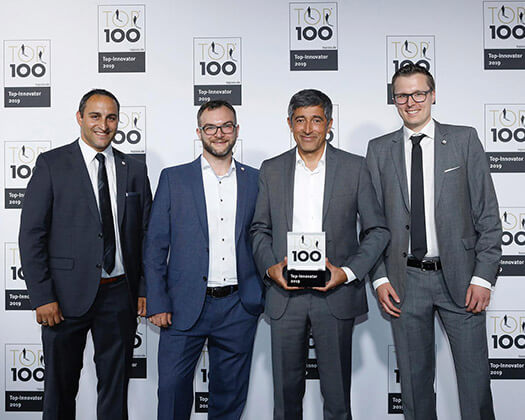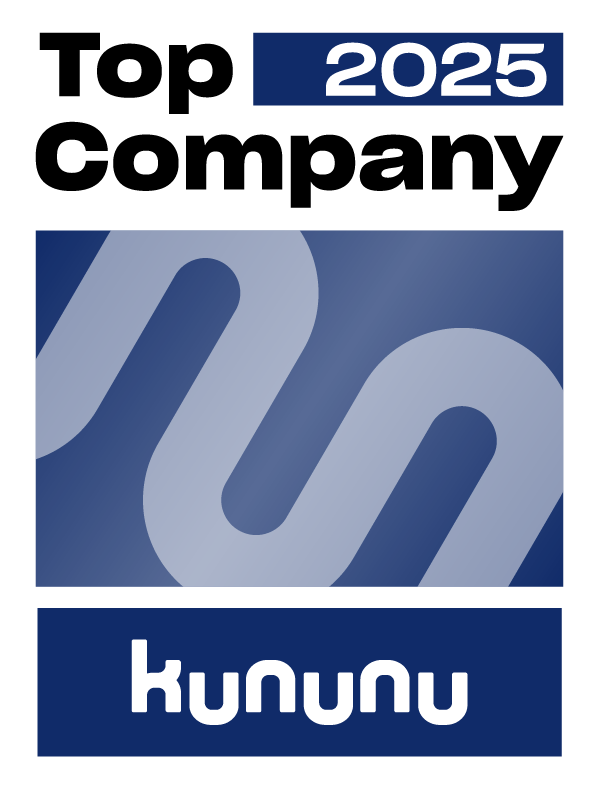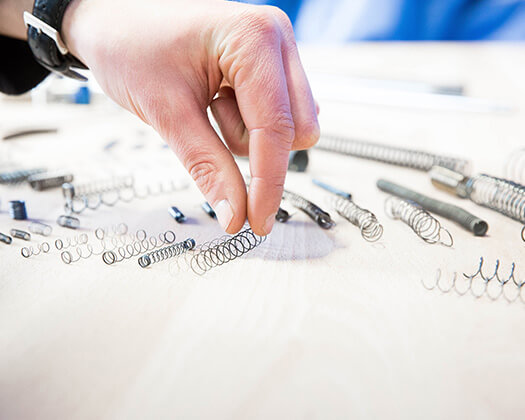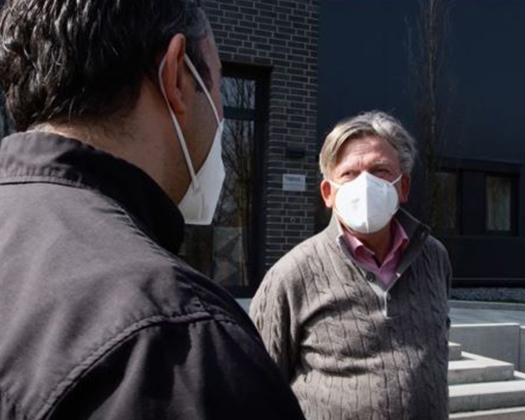Development of Nitinol applications at Ingpuls
Episode 1 is all about Nitinol and the medical technology market: from how and where shape memory alloys are used in medical technology, to the developments that have taken place at Ingpuls in terms of process routes and melt sizes, to how the market
will develop in the future. Our CEO Dr. Christian Großmann and Dr. Uli Mürrle (Senior Advisor – Medical & Material Science) provide exciting insights.
Felix Manhart: Ingpuls has been active in the medical technology market for a year now. What areas has the business developed into?
Dr. Mürrle: We got to know each other two years ago at SMST. At that time, Ingpuls was already very active in actuator technology for industrial applications. I had actually been thinking about it for some time: Ingpuls actually has the potential to enter the medical technology market with the know-how and what they bring to the table.
Felix Manhart: Where are the focal points in terms of product development?
Dr. Ulrich Mürrle: In essence, of course, the first thing is to produce pure nitinol in the melt. Then it’s about producing semi-finished products and advising customers on the manufacture of end products. That’s the direction in which everything is moving at the moment. The starting product is not a major cost factor in the value chain – but it is a factor that has a decisive influence on the quality of the end product.
Dr. Christian Großmann: The end products are, on the one hand, implants such as stents, and on the other, medical instruments such as root canal files. The companies that work in these different areas are medical technology manufacturers. We are learning a lot right now, but we also get a lot of support from the companies.
Felix Manhart: What feedback has Ingpuls received from the market?
Dr. Christian Großmann: Basically, we have received very positive feedback. We had a lot of meetings – at least before Corona – now we have a lot of virtual meetings. We understood where the customers’ bellyaches are and what problems the companies are working on. As a result, we went into the sample phase and made initial melts. From these, we then developed semi-finished products such as rods or wires for the companies. We received very constructive feedback and found that the potential we see in the material is also reflected in the data that the customers send us. There are still some points that need to be improved, such as the homogeneity of the material or the specific details that need to be adjusted on each customer’s semi-finished product. Whether that’s specific diameters to the point, or surface qualities. Ultimately, we are very deeply involved in product development, which makes us very happy and helps us to develop further step by step.
Dr. Ulrich Mürrle: If we work cooperatively with the customer and offer ourselves as problem solvers, we make very fast progress in this atmosphere – that has proven itself. We put our heads together with the customer and implement together. That has worked very well in previous projects.
Felix Manhart: What have you learned in recent months and what progress has been made in the process routes?
Dr. Christian Großmann: Of course, everything starts with the melt. When we produced and analyzed the first melts in 2020, it became clear that we had extremely small precipitates in the material. That’s when you immediately saw the enormous potential. Dr. Mürrle, who has been working successfully in the market for many years, gave us the hint that this was the right way to go and that we absolutely had to keep at it. We produced wire from these melts and it became apparent that you can set new limits in semi-finished product processing if you work with particularly pure material. We succeeded very well in doing this with the wire.The problem then, of course, is that customers’ products with these new properties first have to be developed. Until now, the market has worked with material that had a certain standard. But if you now have a material that – I don’t want to say better – but has other properties that bring with them other possibilities, then there has to be close cooperation and you have to see whether the material can also be used in this way or whether the customer – perhaps together with us – has to develop in a different direction.The bottom line is: we can process the material very well and already have feedback that customers can work well with the material. Nevertheless, there is still some work to be done, of course.
Felix Manhart: Were there any preliminary work or insights that Ingpuls particularly benefited from along the way?
Dr. Ulrich Mürrle: The insight is that small is more beautiful than big. Most manufacturers in this field have large production facilities, large melting furnaces with a long value chain and suppliers, long processing times are accordingly quite normal. Here it is different and that is the charm we have here. We have melting technology, forming technology and final forming technology bundled in one hall. So it would not be unrealistic for the customer to have the finished wire within a week – from melting.
Dr. Christian Großmann: We are very fortunate that we started with the automotive industry. We had to deal directly with correspondingly large quantities and the entire production line that we set up here was explicitly designed for this. The delivery dates are – I don’t want to say just in time – but they are very, very short. We needed a very short lead time at the beginning so that we didn’t have to fill the warehouses to the top.That was the design of the production line: small melts, small batches, in quick succession. In this context, it was important that the individual process steps were well coordinated. This has now helped us a great deal in the development of the medical technology material. Of course, we didn’t get everything right with the first shot. We had to go through various iterations, but then managed to do it in a relatively short time. Within 2 months of the first casting, we had the first wire drawing sections ready, which then also had really good properties.The question in the market is, of course, whether everything fits in terms of quantities and delivery times? But we have long since proven through our experience in the automotive industry that this is possible.
Felix Manhart: For which applications and products are NiTi semi-finished products used, and what are they?
Dr. Ulrich Mürrle: There is a value chain that goes from the melt to the semi-finished products, i.e. wire, tube, sheet, rod – to components that are manufactured from various semi-finished products and then further processed into the implant. In other words, everything we offer has potential to be used in nitinol applications in medical technology. These can be heart valve frames, stent frames, so-called stent-crafts for aneurysms or aortic aneurysms. Or something less sophisticated: files for endodontics, guide wires, cannulas for catheters and examinations, that’s the whole gamut. It remains to be seen whether we can compete and keep up everywhere. But we have the opportunity to offer solutions for all end users – thanks to the know-how available here – that are worth talking about.
Dr. Christian Großmann: We always look at the requirements to see what are the next important steps here at Ingpuls? What machines and systems do we perhaps need to be able to offer even more in the value chain. I think it’s very important that we try to bring as many processes as possible under one roof so that customers have few points of contact, because the products are so complex and demanding. If something is wrong somewhere, you don’t want to have 10 contacts at the table and discuss it with all of them. We have also found in the other markets that working with one contact is optimal. Now we approach medical technology customers with a maximum of one additional contact person, but that still works great. So we take all this information and requirements to see what machines and equipment need to be bought next and what they need to look like so that we can meet the customer’s requirements better and better.
Felix Manhart: What are the main differences between Ingpuls and other market players?
Dr. Christian Großmann: We started with Ingpuls in the field of actuator technology – from consultant to development service provider and only then to manufacturer – so we went through all stages of product development and ultimately built a line just for the automotive industry. At that time, we had no contacts in medical technology. We first tried to do exactly what we thought was right for these products. In other words, we didn’t look at what others were doing: How do others do it? Instead, we considered what was best for nickel-titanium, for the quantity and for the type of alloy we had to produce. And then you, Uli, said something to us at SMST that was actually the decisive impulse for us.
Dr. Ulrich Mürrle: Yes, well: Nitinol is about 60 years old, the industrial application of Nitinol was actually first thought of in actuator technology, that was around the mid-70s – and then came medical technology. At Ingpuls, we have now basically gone through exactly the same steps in three years as happened 60s ago. So we have indirectly learned something from history. We came from the automotive sector, the industrial application, and are now moving into the medical technology sector. Historically, this has all happened before in the 60s, since Nitinol was known.
Dr. Christian Großmann: The biggest difference is that we have a completely different production approach. We also have to work in a very customer-oriented way, because actuator applications are very complex and require a lot of explanation. You can get a million things wrong, and the fact that we have become successful in this area was only possible because we learned to enter into a very close dialog with customers. I think, Uli, you have always said that this customer orientation is a characteristic that is very important for us from your point of view so that we can go into the market and that is now also showing in the last few months.
Dr. Ulrich Mürrle: It also shows in communication. Other companies have a sales department, have technical expertise that is stored in different places. That means they have much longer information chains until something is processed. With us, everything is concentrated, we sit down with the customer, talk once and then in the best case – I come from Baden-Württemberg – it’s “beschwätzt”.
Felix Manhart: How have melt sizes developed at Ingpuls in recent years?
Dr. Christian Großmann: Melt sizes at Ingpuls – that’s a very exciting question that most of our customers are interested in. For that, you have to look at our history a bit. We spun off Ingpuls from the Ruhr University in Bochum. At the RUB, there were two ways to produce melts. One was a vacuum induction melting furnace, with which we melted 1 kg of ingots with a diameter of about 40mm, and then we had an electric arc furnace, with which we could melt small buttons, of 60 grams. For the first developments we made, we worked with 1 kg of melts. For the first series that we started to produce in 2016, we made a big jump – to 3 kg. :)Of course, that wasn’t much either, but that’s how we started honestly in the market and then started to process those 3 kg melts. Then about 1.5 years ago we went from 3 kg to 5 kg because we bought new forging machines. These forging machines needed a certain minimum length in terms of ingots to be able to forge with them at all. And today we are at 12 kg, so we have taken the next step and are in the process of qualitatively characterizing this melt size and steering it into the projects. But the next step is already around the corner, because in a few weeks we will welcome the second melting furnace and then we are aiming for a melt size of 25 kg, which will be another big leap.
Dr. Ulrich Mürrle: That sounds like quite an organic development, even though others may say. “Look at Ingpuls, they are already at 25 kg now, we are at 3 tons…”. That’s what a competitor might say.That’s good from the quantity point of view, but on the other hand, we have the experience with the small quantities that we do. And when we scale up from 1, 3, 5 to 12 kg and even 25 kg, we still know what to do, or how to make the ingot so that it has end properties that meet the requirements in terms of fatigue, corrosion and surface quality in the finished product. And we’re always thinking about that – even in terms of our small melts: What will the final product be and what requirements do we have to meet?
Dr. Christian Großmann: At this point, you always have to consider what is actually made from the ingot? If the material is further processed in certain stages, i.e. if it is used to make tubes for stents, for example, then the rods that are produced must also be shipped at some point to the person who makes tubes from them. And then it’s not much use if we have a huge ingot, but then have to split it up into many rods. If the quality ends up being a higher level because we’re making smaller quantities and they fit well from the portioning or the delivery quantities – but also from the lengths that come out in the end…it’s perfectly acceptable to do it that way. The advantages of upscaling are also obvious, of course. The setup costs per ingot are lower, but on the other hand, you also have to see that the production machines become very large and expensive – and they have to refinance themselves at some point. So the path we have now taken feels good from a technical and factual point of view. And it is also economically okay, as we see in the figures. We can also offer these small volumes competitively, and that’s okay for now. So we see to it that we get as high as possible in this way, but also only as high as necessary so that there are no difficulties with the customers at the end.
Felix Manhart: Related to the impurities with carbon and oxygen? What do the results mean for properties, fatigue and the corrison behavior of the materials?
Dr. Ulrich Mürrle: There are numerous publications on the subject of the influence of surface quality and microstructure on the fatigue properties of nitinol. It is a general consensus that oxide and carbide inclusions or their combination lead to deteriorated fatigue behavior. This discussion has been going on for 20 years, and we want to build on this scientific basis and develop the material in such a way that the end customer has no problems with inclusions, inclusions in combination with voids, or with inclusions on the surface. We want to avoid that at an early stage, and I think we’re preaching to the choir and the end customers.
Dr. Christian Großmann: The fact is that at Ingpuls we work with the vacuum induction melting process. This results in very low oxygen impurities, but somewhat higher carbon impurities. The amount in itself is one thing, but the distribution of the precipitates that ultimately form during the solidification process after melting and also after processing the ingots into a semi-finished product, a rod or a tube, is what is often discussed in the publications: What exactly is the starting point for a crack? Where does it start, where does the contamination begin? Are large impurities worse than small ones, or are certain distribution patterns, e.g. the stringing together of several impurities (stringers) to form a chain, decisive? There is much debate about this…What we have found is that our basic setup leads to pretty decent impurity levels. The fact that we do small melts leads to very, very small precipitates, and yet the fact is that the melting process alone is not everything, but also the downstream processing. The transfer points from our semi-finished product to the downstream processor must be extremely well understood in order to be able to drive the process chains accordingly. If you take all this into account, you can produce extremely good materials that are clearly superior to those on the market today.
Felix Manhart: What are the next steps to meet customer requirements even better, for example in terms of production, properties and semi-finished products?
Dr. Ulrich Mürrle: We currently have a limited value chain: we master melting, hot and cold forming after melting, and wire drawing. What we don’t do yet is the production of tubes; we have to rely on partners for that. We don’t want to produce finished parts and compete at the moment. But we need to talk to the end user to avoid surface defects that only become visible in production. There are applications with implants that achieve extremely high surface quality. We currently have a case where we have to do a second iteration to make sure the customer gets his desired result. We are willing to do these iterations because we want to solve the problem.To do that, you have to know that a product development in medical technology or the development of a new stent or a heart valve takes 3, 5, 7 ,8 or even 10 years…sometimes it is stopped after 3 years and you have to respect that. And accordingly, you have to be prepared for the fact that not everything that looks great will end up being a commercial success.
Dr. Christian Großmann: It’s actually always the interface that has to be discussed and designed as perfectly as possible. The better we understand what the next processing steps are at the next stage of the value chain, the better we can prepare our material for them. If we implement all processes exactly as we have been used to, then we will reach a satisfactory state.But who says that is the best we can achieve? And that is exactly where we are today, so we can say:Some of our products are now entering the market, and not where the implants are, because there, of course, the approvals, testing procedures and studies take a little longer. But there is still a lot of potential and we are just at the beginning. We have reached the top level, but now we are going deep into the details. Every single step in our process is now being scrutinized again to see if we can’t optimize or intensify something here or there, or process the material a little more gently. These were the lessons we learned from the other markets in the first few years: You start with something and you also see progress, but it’s not optimal yet. And then there’s a huge space where you can optimize – and that’s where we are now. The solution is: listen, talk, do…listen again, talk, do, and that’s the loop we’re in right now with many companies.
Felix Manhart: How is the establishment of the new Ingpuls material shaping up against the background of regulatory requirements for medical products?
Dr. Ulrich Mürrle: In Europe, there is new legislation for medical devices. The core of this legislation is the traceability of the material back to the beginning. For a manufacturer of a nitinol implant, this sounds terrible, because he now has to trace the material back to the melt and to the manufacturer of the semi-finished product and beyond. For us, it’s more of an advantage that we know which raw material from which batch goes into which pot at which time. Many of our customers and competitors don’t know that, and we can guarantee and disclose to our customers the traceability back to the primary melt. So at the moment we see this more as an advantage than a disadvantage for us – simply because we are positioned in this way.
Dr. Christian Großmann: Exactly, this is something that comes from Ingpuls’ past, namely from the automotive industry. There, it is common practice that the entire supply chain is monitored and controlled. And there, traceability has been necessary from the very beginning. A car consists of 20,000-30,000 individual parts, and if there are critical parts somewhere that lead to an accident and people dying, that’s the end of the fun. And that is no less important in medical technology. For us, this traceability is nothing new; we can fall back on proven structures and processes here…so this regulatory requirement does not bother us.The other side of the regulatory requirements in medical technology, is the time span until an inquiry becomes a serial product. You have to classify and differentiate the different types of medical devices: Permanent implants, Class 2, Class 3 products, etc. For the product classes that don’t have quite such a long regulatory phase, the time-to-market is very short – we’re already there, and that of course makes us happy. You have to look at the whole thing holistically. If Ingpuls says we want to establish ourselves in medical technology and act as a reliable supplier, then we can’t just focus today on implants that won’t generate sales for another 3, 5, 7 or 8 years, but we have a phased strategy. Today, we are already doing a part with the somewhat simpler products, and then at some point we will move in the direction of class 2 and also class 1. Of course, you have to start with this today in order to then have the claim to achieve sales in 5 or 7 years. That’s why we are very active in this area.
Felix Manhart: The topic of nitinol powder for additive manufacturing is also gaining more and more acceptance, what is behind this?
Dr. Ulrich Mürrle: It is new territory in medicine, but also new territory in industrial applications. I had already looked into it a little more closely some time ago. At that time, the topic was only in a kind of nucleation phase. At that time, we atomized and sold a few kilograms. Today we are in the range of a few tens of kilograms. There seem to be applications in the market, both industrial and medical, where nitinol powder is used either in finished parts or in surface coatings to create certain properties. So I definitely see a positive future there. But again, you have to master it from the beginning: From the melt, to the property of the cast ingot or the forging ingot, which is then atomized into powder. You have to take that into account and look at it carefully to get a good result. I think we are well positioned there, too.
Dr. Christian Großmann: Last year, we sold several kilograms – I think well over 100 kg – of material, which was then atomized into powder. There are two technological trends that are emerging at the moment: One is medical alloys, and the other is that additive manufacturing is focusing on very brittle sma. That is, high-temperature alloys that are not very ductile by nature and have very high processing costs on the way from the melt to the semi-finished product. Those are the two technology topics, the approaches – that’s where we get all the inquiries. A lot of things are coming together: Additive manufacturing is a hype, then there are already all the generative manufacturing processes. The equipment is already available for purchase – as if off the shelf: EBM, SLM, LMD systems…and the people who have these systems first work with structural materials and then they also start to work with functional materials. Then, of course, the focus goes very quickly to nickel-titanium and people ask for nitinol powder. Often there are no suitable suppliers on the market, so we said, “OK, we’ll set up appropriate interfaces with our partners who will atomize our melts together with us to create a contact point for customers.We’re already getting very large inquiries in the ton range, but it’s like with all things. You have to get it right and at the beginning sometimes correct the request because it’s often put together with old information from the past – simply because you don’t know any better. But if you can already see that something doesn’t fit into the process, for example, nickel evaporates or oxygen flows into the process, etc….If I know what the end properties should be, I have to get everything right at the beginning. That’s where we are, and that’s where we try to talk to the customer together to set the requirements correctly and then be able to deliver. And then it’s our part to support this topic.
Felix Manhart: Where is Nitinol headed in medical technology: future or discontinued model?
Dr. Ulrich Mürrle: Future. There are or have always been studies on brand development for Nitinol components in the medical technology market. Since 2012, this market has grown by about 10% per year and is expected to continue to grow until 2025/2026, because more and more applications are being converted to Nitinol or new developments are also causing the market itself to expand. Another point is that the applications or technologies for using Nitinol in the human body are being simplified or improved. There is also potential for introducers and the like. This is not our field, but it is worth talking to competent experts in this field, and then maybe one or two things will come out. So I’m optimistic about that.
Dr. Christian Großmann: I see it that way, too. We’re also watching the whole thing geopolitically and economically on a global scale, and we’re seeing markets and countries that are starting to develop a standard of living. The standard of living also includes the standard of medical care. That’s becoming more and more developed, in Asia, but also in the Middle East, in India. We are talking here – in China and India alone – about almost 3 billion people who do not yet have the kind of medical care that we have here. And especially when it comes to implants, there are more and more companies that are also producing in India or Indian companies that are entering the market. Put it this way: The life of the materials will extend the life of the implants. That will allow a larger user group to use them. If the stents last not 15 years but 30 years, then the stents can be given to younger patients, that’s a factor. Then the markets in general will grow, there will be more applications, and then there will be more markets. So actually you have to say, if you look at everything together: It doesn’t go on linearly, it would have to accelerate even more in the next few years.
Felix Manhart: What are the further plans for medical technology – for example, also with regard to possible partnerships?
Dr. Christian Großmann: We are not only in talks with many, many companies, but also in ongoing development projects and would like to bring these development projects to a successful conclusion one after the other. It is true that some companies are interested in intensifying the partnership. We’ll just have to wait and see what happens in the end. But the limited opportunities to bring nickel titanium to market are, of course, also a risk for companies that are just looking to grow. So when you have proven that you can supply certain grades reliably and reproducibly, then of course you talk about long-term supply contracts. That is our wish and also our goal, that is what we want to achieve. Only time will tell whether these contracts will remain or whether they will develop into closer partnerships. At the moment, it looks like we’ve had a good start and now we have to continue, because the race is not won with the start.
